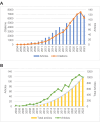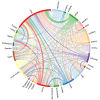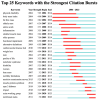Mapping Knowledge Landscapes and Emerging Trends of Sarcopenic Obesity in Older Adults: A Bibliometric Analysis From 2004 to 2023
- PMID: 38873392
- PMCID: PMC11170931
- DOI: 10.7759/cureus.62300
Mapping Knowledge Landscapes and Emerging Trends of Sarcopenic Obesity in Older Adults: A Bibliometric Analysis From 2004 to 2023
Erratum in
-
Correction: Mapping Knowledge Landscapes and Emerging Trends of Sarcopenic Obesity in Older Adults: A Bibliometric Analysis From 2004 to 2023.Cureus. 2024 Aug 20;16(8):c190. doi: 10.7759/cureus.c190. eCollection 2024 Aug. Cureus. 2024. PMID: 39170643 Free PMC article.
Abstract
Background The prevalence of obesity in combination with sarcopenia, the age-related loss of muscle mass and strength or physical function, is on the rise among adults aged 65 years and older. A significant portion of this demographic now falls under the classification of sarcopenic obesity, a high-risk geriatric syndrome predominantly seen in an aging population vulnerable to compounded complications from both sarcopenia and obesity. It is essential to promptly evaluate the impact of academic research in this field, taking into account factors such as geographical regions, authors, journals, and institutions. Furthermore, exploring current topics and identifying potential areas that could inspire future researchers to conduct additional studies is crucial for advancing overall health in this population. Methodology A search was conducted in the Web of Science Core Collection database to identify English language articles and reviews focusing on sarcopenic obesity in older adults, published between January 1, 2004, and December 31, 2023. Bibliometric analysis was performed using VOSviewer (v.1.6.18) and CiteSpace (v.6.1.R2). Results A total of 985 original English-language articles were collected, consisting of 783 articles and 202 reviews. The volume of research publications in this field has shown significant growth since 2012. The United States leads in contributions, with 239 articles (24.3% of the total) and the highest number of citations at 18,403, along with the highest total link strength. The University of Melbourne in Australia stands out with 25 published articles (2.5% of the total). University of Verona in Italy has the most citations at 9,405, and Monash University in Australia has the highest total link strength at 53. Among prolific authors, John A. Batsis from Duke University is the most productive with 24 articles (2.4% of the total). The journal "Nutrients" has the most articles on sarcopenic obesity in older adults, publishing 54 articles (5.5% of the total). Key topics in this area include sarcopenia, obesity, sarcopenic obesity, and elderly. Recent interventions focus on "nutrition" and "exercise" for sarcopenic obesity in older adults. Conclusions Research on sarcopenic obesity in older adults has seen significant growth on a global scale from 2004 to 2023, indicating a promising area for further study with potential benefits from current advancements. Although academic inquiries have shed light on various aspects of sarcopenic obesity in older adults, there remains a noticeable dearth of clinical research and evidence-based medicine on the effective management of this condition in elderly individuals. Future studies could focus on developing tailored interventions for older adults with sarcopenic obesity.
Keywords: bibliometric analysis; citespace; obesity; older adult; vosviewer; sarcopenia.
Copyright © 2024, Zhang et al.
Conflict of interest statement
The authors have declared that no competing interests exist.
Figures














Similar articles
-
Research Hotspots and Trends of Interventions for Sarcopenic Obesity: A Bibliometric Analysis.Cureus. 2024 Jul 16;16(7):e64687. doi: 10.7759/cureus.64687. eCollection 2024 Jul. Cureus. 2024. PMID: 39021741 Free PMC article. Review.
-
Mapping Knowledge Landscapes and Emerging Trends of the Links Between Frailty and Heart Failure: A Bibliometric Analysis From 2000 to 2023.Cureus. 2024 May 17;16(5):e60511. doi: 10.7759/cureus.60511. eCollection 2024 May. Cureus. 2024. PMID: 38764704 Free PMC article.
-
Landscape and research trends of sarcopenic obesity research: A bibliometric analysis.Heliyon. 2024 Jan 13;10(2):e24696. doi: 10.1016/j.heliyon.2024.e24696. eCollection 2024 Jan 30. Heliyon. 2024. PMID: 38304815 Free PMC article. Review.
-
Publication trends in nutrition research for sarcopenic obesity: A 20-year bibliometric analysis.Medicine (Baltimore). 2023 Nov 3;102(44):e35758. doi: 10.1097/MD.0000000000035758. Medicine (Baltimore). 2023. PMID: 37933069 Free PMC article.
-
Research hotspots and trends of sarcopenia in orthopaedic surgery: a bibliometric analysis from 2003 to 2023.Front Surg. 2025 May 6;12:1564923. doi: 10.3389/fsurg.2025.1564923. eCollection 2025. Front Surg. 2025. PMID: 40395747 Free PMC article.
Cited by
-
Geriatric Trauma: Identifying Research Gaps and Opportunities for Improvement.Cureus. 2024 Jul 22;16(7):e65135. doi: 10.7759/cureus.65135. eCollection 2024 Jul. Cureus. 2024. PMID: 39171008 Free PMC article. Review.
-
Applications of artificial intelligence in orthodontics: a bibliometric and visual analysis.Clin Oral Investig. 2025 Jan 16;29(1):65. doi: 10.1007/s00784-025-06158-y. Clin Oral Investig. 2025. PMID: 39821532 Free PMC article. Review.
-
Research Hotspots and Trends of Interventions for Sarcopenic Obesity: A Bibliometric Analysis.Cureus. 2024 Jul 16;16(7):e64687. doi: 10.7759/cureus.64687. eCollection 2024 Jul. Cureus. 2024. PMID: 39021741 Free PMC article. Review.
-
Effect of resistance training on body composition and physical function in older females with sarcopenic obesity-a systematic review and meta-analysis of randomized controlled trials.Front Aging Neurosci. 2025 Apr 30;17:1495218. doi: 10.3389/fnagi.2025.1495218. eCollection 2025. Front Aging Neurosci. 2025. PMID: 40370749 Free PMC article.
References
-
- Body composition in healthy aging. Baumgartner RN. Ann N Y Acad Sci. 2000;904:437–448. - PubMed
-
- Global prevalence of sarcopenic obesity in older adults: a systematic review and meta-analysis. Gao Q, Mei F, Shang Y, Hu K, Chen F, Zhao L, Ma B. Clin Nutr. 2021;40:4633–4641. - PubMed
-
- Asian Working Group for Sarcopenia: 2019 consensus update on sarcopenia diagnosis and treatment. Chen LK, Woo J, Assantachai P, et al. J Am Med Dir Assoc. 2020;21:300–307. - PubMed
LinkOut - more resources
Full Text Sources
